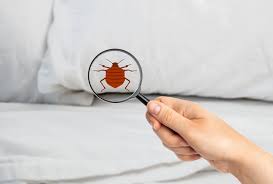15% discount on all bed bug heat treatment services.
30 Days Complete Eradication Guarantee*
15% discount on all bed bug heat treatment services.
30 Days Complete Eradication Guarantee*
Bedbug Infestation: How to get rid of bed bugs
Bedbug infestations can be a distressing and frustrating experience. These tiny, nocturnal creatures feed on human blood and can cause itchy bites and sleepless nights. We will share our knowledge to answer the question ‘how to get rid of bed bugs’.
Firstly, it is important to understand the signs of a bedbug infestation. Bites and blood spots on the bed sheets are typically most obvious signs as well a live sighting. If you are un sure you can contact one of our trained professionals to provide advice or visit our shop where we sell a selection of bed bug monitors which you can place around your bed.
For infestations, the most successful treatment available is heat treatment and you can find out more by reading here.

Visual Inspection: Thoroughly examine your mattress, bedding, and furniture for any signs of bedbugs. Look for small reddish-brown stains, dark fecal spots, shed skins, or live bugs hiding in crevices, when in doubt contact our team for some free advice.
Bed Bug Monitoring Devices: Set up passive monitors or sticky traps near your sleeping area to capture any bedbugs that may be present. These devices can help you track the severity of an infestation and guide treatment decisions, you can purchase these through our online store.
Bed bug are expert hiders and can squeeze into tiny spaces. Therefore, a professional inspection is recommended.
Bedbug Identification
Trapping Bedbugs
Bedbug traps are effective tools to capture bedbugs in your home, however they will not completely eradicate an infestation.
By trapping bedbugs, you will identify the level of infestation but it will not be possible to achieve complete eradication.
Cleaning Tips
It is recommended after vacuuming that you empty the contents into a bin and remove outside to prevent it spreading to other areas of the house.
Discarding Infested Items
When dealing with the removal of infested items, it is essential to take prompt and decisive action. Eliminating infested items is a crucial step in eradicating bedbugs from your living space effectively.
To properly discard infested items, follow these three steps:
It is important to note that discarding infested items alone may not completely eliminate a bedbug infestation. It should be done in conjunction with other treatment methods to achieve optimal results.
Taking swift action when discarding infested items is crucial in preventing further.

Talk to us about Bed Bug Pest Control
Call us on 0808 189 2310 - or complete our Free Quote Form below.
Learn about our Bed Bug Pest Control Services
When it comes to dealing with the persistent problem of bedbugs, it is highly recommended to use heat treatment. It is 100% effective and penetrates all the cracks and crevices that DIY methods and chemical treatments do not reach.
Bed bug heat treatment is a method used to eliminate bedbugs by subjecting them to high temperatures. This approach relies on the sensitivity of bedbugs to heat, as they cannot survive when exposed to temperatures above a certain threshold.
During high heat treatment, specialised equipment is used to raise the temperature in infested areas to levels that are lethal to bedbugs. The heat penetrates deep into cracks and crevices where bedbugs may hide, effectively killing them and their eggs.
One advantage of high heat treatment is that it does not involve the use of chemicals or pesticides, making it a safer option for those concerned about potential health risks. Additionally, this method can be targeted towards specific areas, reducing the need for extensive treatment throughout an entire space and can usually be completed in a single day.
It’s important to note that high heat treatment should be performed by trained professionals who have experience in using the equipment safely and effectively.
Chemical treatments have been traditionally used to treat bed bugs, however the success rate for complete eradication is much lower than heat due to not being able to penetrate the cracks and crevices and areas that bed bugs are in.
If you think you have a bed bug infestation at your home or business, then it is very important to act fast. Bed bugs can live up to 12 months and lay over 500 eggs in this time- which gives them plenty of opportunities to multiply.
Remember, that bed bug treatments work best when infestations are detected early and are eradicated permanently. It’s always best to contact a professional company for bed bug treatments to ensure complete eradication. Our friendly bed bug heat treatment team will be happy to discuss your options and any questions you may have.
Free Quote
Free Quote for all Bed Bug Treatments Nationwide
"*" indicates required fields
Free Quote
Free Quote for all Bed Bug Treatments Nationwide
"*" indicates required fields